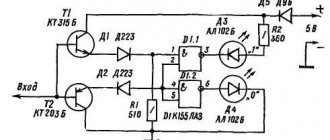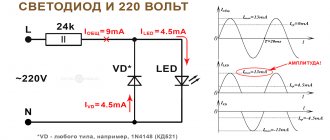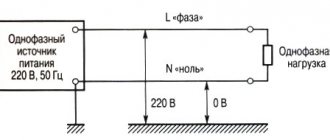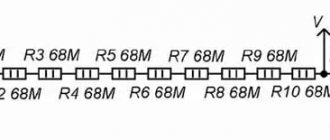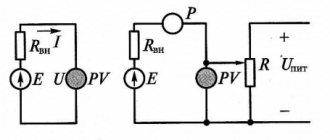Review of individual electrical safety equipment “There are no trifles in the electric power industry”
The article discusses new electrical testers, indicators and voltage indicators, which are an important category of control and diagnostic electrical equipment. Made on a modern element base, taking into account harsh operating conditions, they serve to detect dangerous voltage, determine the correct phase sequence when connecting circuits, thereby ensuring the electrical safety of electricians, installers, builders and other categories of electrical personnel whose activities involve the risk of electric shock.
Indicator testers, high voltage indicator detectors, phase sequence meters, all these devices are most in demand during construction, installation and commissioning work. The safety of personnel servicing existing electrical installations (EI) largely depends on the reliability, quality and convenience of these devices.
Portable indicators for indicating phase voltage and determining its value, as an independent group of devices, have been known for quite a long time. Several years ago, contact indicators were widely used, which usually included elements connected in series: a probe (usually in the form of a screwdriver), a current limiter, a diode (neon) light bulb and a touch pad. When the tip of the probe came into contact with the phase conductor and touched the touch pad, the light came on, signaling the presence of a dangerous potential. The main disadvantages of such indicators were: checking for the presence of dangerous voltage using the contact method (on exposed sections of wiring) and a relatively narrow operating voltage range (up to 220 V/380 V).
Currently, indicator testers for non-contact detection of high voltage with increased functionality are widely used. A modern multi-mode individual voltage detector can be used in almost all areas of human industrial activity. For electrician specialists, for whom a simple indicator is sometimes not enough, complex devices have been developed that allow not only to detect phase voltage, but also to determine the order of phase rotation, as well as determine the order of connecting windings in order to control the direction of rotation of electric motors.
Pocket indicator testers
Figure 1. Single-pole phase voltage tester-indicator HT70
If it is necessary to determine only the presence/absence of voltage during operational monitoring of equipment (when working directly in electrical circuits and live parts of the power plant), hazardous voltage indicators can be successfully used.
One of these compact devices is the HT70 (Fig. 1) from the company HT Italia (Italy). HT70 is a multifunctional voltage detector that combines a phase voltage detector in the range of 100 ... 1000 V at a frequency of 50 Hz and a tester for determining the phase sequence.
The device is made in a pencil-type case with a sliding battery compartment cover. The presence of phase voltage is signaled by the continuous red glow of the high-brightness light-emitting diode (LED) built into the tip of the probe and the activation of the sound detector (Fig. 2).
Figure 2. The test result is visualized by a 2-color LED: green – means a positive test result; red color with a sound signal – negative (error in the phase sequence).
HT70 detector has a unique patented single-pole detection mode for correct phase rotation in a three-phase network. It can be used to determine the in-phase behavior in various control switchboards (search for circuits of electrical installations connected to the same phase), which in turn allows one to evaluate the direction of rotation of electric motors.
HT70 indicator tester has a clearly visible warning marking of the safe containment zone when working with live objects. The indicator is powered by 2 1.5 V batteries (AAA type), test life of at least 9000 tests. To save battery life, use the auto power off function (turns off after 5 minutes of inactivity).
The special feature of the HT70 is that the detector allows circuit testing without the need for galvanic contact, in other words, the search can be performed even on insulated conductors. With such non-contact detection, there is no need to search for current-carrying elements, the connecting terminal, or to strip the dielectric braid of the cable. Non-contact testing using HT70 is extremely safe, very convenient and efficient.
If there is a need only to determine the presence of phase voltage, then the VP-1 (Fig. 3) from APPA (Taiwan), which is designed for “harsh” operating conditions, can successfully cope with this task.
Figure 3. APPA VP-1 Pocket Voltage Detector (Voltpen)
The APPA VP-1 indicator is similar in technical characteristics and design to the HT70 , but has an end-mounted battery compartment cover and a sealed housing (IP-65). Such a high level of housing protection means that the device can be used in conditions of high humidity (dew), it is almost completely protected from the penetration of dust and dirt. An interesting feature of this indicator is that the acoustic buzzer signal automatically varies depending on the phase voltage level at the point being tested. Non-contact voltage detection, a sealed housing and an attractive price make this device an indispensable assistant for an electrician.
The main technical characteristics of the indicators are given in the table below (including a number of similar models from other manufacturers for comparison).
Table: main technical characteristics of pocket indicator testers
| Options | APPA VP-1 | HT70 | Fluke 1AC II | LVD-15 |
| Range | 200…1000 V | 100…1000 V | 200…1000 V | 50…1000 V |
| Voltage frequency | 50/60 Hz | 50/60 Hz | 50/60 Hz | 50…500 Hz |
| Visual indicator | red LED | red and green LED | red LED | red LED |
| Acoustic indicator | Variation buzzer | Buzzer | Buzzer | Buzzer |
| Determination of phase rotation | No | Yes | No | No |
| Safety | IEC/EN61010-1, 1000V (cat IV) | IEC/EN61010-1, 1000V (cat IV) | IEC/EN61010-1, 1000V (cat IV) | IEC/EN61010-1, 600V (cat III) |
| Degree of protection, IP | 65 | — | 40 | — |
| Temperature | 0 °C … 50 °C | -10 °C … 50 °C | -10 °C … 50 °C | 0 °C … 40 °C |
| LED flashlight | No | No | No | Yes |
| dimensions | 18 × 151 × 22 mm | 20 × 160 × 26 mm | 148 mm | 28 × 142 × 27 mm |
| Weight | 120 g | 48 g | 100 g | 45 g |
Carefully! Non-contact voltage indicator 1AC-D
This device was ordered specifically to warn buyers and users about the features of working with it. I myself do not use such devices for their intended purpose and do not recommend them to you. Sent in a bag
The look is quite nice, the design is comfortable, there is a clip for attaching it to your pocket.
When triggered, it beeps loudly intermittently and the red LED under the white plastic tip blinks. Powered by two AAA batteries
There is no power switch and is not required, because... in standby mode, the device consumes only 0.3 μA, which is significantly less than the self-discharge current of the batteries. Naturally, the device was disassembled. The sensor itself is a regular resistor with long leads. Instead of a resistor, any piece of wire will work with the same success. Apparently the resistor was easier to solder. A simple circuit based on Schmidt triggers in 74HC14D lib.chipdip.ru/223/DOC000223080.pdf
The sensitivity is determined by the resistor value of 200 MOhm (rare for SMD), a higher value means higher sensitivity. The backlight LED is turned on directly by the button and is overloaded on fresh alkaline batteries. I just added a 9.1ohm resistor across the circuit to keep the LED from burning out.
The device is a simple indicator of an alternating electromagnetic field that responds only to the electrical component. The sensing distance to the live wire is 1-2cm. This device DOES NOT RECEIVE static, high-frequency and magnetic fields. The device does not work as a hidden wiring detector - the detection distance is too short and any conductive surfaces block the passage of noise from the wire.
So, why do I strongly advise against using such devices as voltage indicators? They DO NOT GUARANTEE that hazardous voltage will be free and may therefore be misleading. The device responds not to the voltage itself, but to the alternating field created by it. But the problem is that a live wire does not always create this very field. For example, if a wire passes next to a metal grounded surface or simply lies on the Earth, the field will be well shielded and the device will not show anything. In order not to be unfounded, I show this feature in the video; in this case, the hand, even on the back side of the wire, was a screen
Another feature is that if the body of the device and especially its tip are wet or dirty, the sensitivity decreases sharply.
If you really want to buy a simple detector, then for the same money it’s better to buy such a universal one with a switch (manufactured under different brands)
Or just use an indicator screwdriver with a neon light.
It is even better and more correct to check the presence of voltage with a multimeter 
Conclusion: I strongly do not recommend taking, let alone using, the device as a voltage indicator.
Personal Hazardous Voltage Detectors
Individual detectors of dangerous voltage are necessary not only for personnel servicing the power plant. Such devices are also necessary for employees working in conditions of possible dangerous proximity to high voltage sources (for example, firefighters, rescuers). In such situations, it is convenient to use individual wearable detectors, which are prepared for attachment to work clothes or protective equipment. Such a constantly worn individual device is the voltage indicator 286 SVD (Fig. 4) from SEW (Taiwan). This high-voltage detector has several mounting options: using a clip - on a belt or pocket, using an elastic belt - on a headgear (helmet) or on the forearm (Fig. 5).
Figure 4. 286 SVD Hazardous Voltage Indicator Figure 5. Application of 286 SVD Hazardous Voltage Indicator
The device operates very simply. After switching on, it is always in the on state; immediately before performing work in the control unit, a functionality check procedure is performed. When a person with a detector approaches a high voltage source, the detector emits a short warning beep. The acoustic notification is accompanied by the blinking of a bright LED that is clearly visible even in daytime. This signals that you are approaching a dangerous voltage source and that you need to remain alert and follow safe work practices. For example, the safe detection distance for a phase voltage of 11 kV for reliable operation of the sensor is 80 cm. The detector can be used both indoors and outdoors. 286 SVD detector housing is waterproof.
The older model in this series of devices, 288 SVD (Fig. 6), has more advanced characteristics. Firstly, it has a more sensitive sensor: a detection distance of 4.75 m for a nominal value of 10 kV. Secondly, this detector is equipped with a waterproof and dustproof housing with a dust and moisture protection class of IP65. Thirdly, a low battery indicator. And fourthly, a louder buzzer and an increased brightness indicator light.
Figure 6: 288 SVD Hazardous Voltage Indicator
| Options | 286SVD | 288SVD |
| Voltage range | Up to 11.4 kV | Up to 50 kV |
| Sensing distance | ~80 cm | 5 cm...10 m |
| Visual indicator | Red LED | Red LED |
| Acoustic indicator | Buzzer | Buzzer |
| terms of Use | 5 ºС….45 ºС; relative humidity no more than 80% | -15 ºС….55 ºС; relative humidity no more than 93% |
| Degree of protection, IP | waterproof | 65 |
| Belt clip and strap | Yes | Yes |
| Nutrition | CR2032 3V x 1 | “Crown” 9 V x 1 |
| dimensions | 59 x 56 x 18 mm | 115 x 67 x 30 mm |
| Weight | 35 g (with battery) | 146 g (with battery) |
High-voltage hand-held voltage detectors
Hand-held high voltage detectors (up to 275 kV) are mainly used in power plants, power substations, in the production of electrical installations and in laboratory research.
The non-contact detector 275 HP (Fig. 7) from SEW is a multi-range adjustable detector with a switch for 8 voltage ratings (from 240 V to 275 kV). The 275 HP consists of an internal touch plate, sensitivity switch, visual and audible alarms.
Figure 7. 275 HP Hazardous Voltage Detector
The detector's sensitive element registers the field surrounding the live conductor. The voltage indication distance of 250 V for a single-core cable is 10 cm; when working with multi-core wires, the indication distance drops to 5 cm.
275 HP indicator can be used in the following cases: detection and testing of live cables; identifying damage to flexible cables; checking equipment for grounding; neon lamp maintenance; checking high-frequency radiation, detecting residual or induced voltage. The main thing to remember is that this indicator is used for non-contact voltage detection, and under no circumstances should you allow contact with a live object. Direct contact of the device with the power element can lead to its failure and the risk of electric shock.
The detector is equipped with a high-volume buzzer and a bright light (LED) indicator, which allows you to notice the signal of the presence of dangerous voltage even in places with high noise levels or low light levels.
In addition to the serviceability monitoring mode, the 275 HP detector has a self-diagnosis function for the operation of the device. To test for functionality, simply set the sensitivity range switch to the “240 V” position and then rub the sensor cap (sensitive element) on the fabric of your clothing to create discharges of static electricity. The appearance of a sound and light signal indicates the serviceability of the device and its correct functioning.
For additional convenience and safe operation of the detector, it is possible to attach it to various dielectric extension rods (Fig. 8). At the end of the 275 HP handle there is a universal mounting hole (eyelet). Thanks to the presence of fixing grooves, the indicator can be mounted on the rod at any angle.
The presence of several rod bends and a dovetail clamping mechanism make it possible to ensure a safe distance from the operator to the source of dangerous high-voltage voltage.
Figure 8. 275 HP on HS-120 Extension Rod
The 276 HD detector (Fig. 9) is a high voltage indicator and is designed to operate in two ranges: 80 ... 600 V and 3.3 ... 24 kV. It is made in the form of an extension rod. The detector has a sliding telescopic rod (3 sections): when folded, its length is ~35 cm; when extended, the length of the rod increases and reaches 1 m, which allows you to check the presence of dangerous voltage in hard-to-reach places (at a safe distance). The detector is equipped with a protective rubber handle, which effectively protects against electric shock.
Figure 9. 276 HD Hazardous Voltage Detector
To detect voltages in the range of 80 ... 600 V, an electrode tip is used in the detector head for galvanic communication with the voltage source. To detect voltage in the second range (from 3.3 to 24 kV), direct contact with the source is not required; it is enough to bring the indicator head closer to the voltage source at a distance of 1 to 20 cm.
276 HD indicator has a dust- and waterproof housing, which completely protects the indicator’s sensor unit from dust, dirt, and water and allows you to operate the device outdoors in any weather conditions.
Table: main technical characteristics of high-voltage hand-held voltage detectors and indicators
| Options | 275 HP | 276 HD |
| Range | from 240 V to 275 kV | from 80 to 600 V from 3.3 to 24 kV |
| Sensing distance | up to 10 cm | up to 20 cm |
| Visual indicator | Red LED | Red LED |
| Acoustic indicator | Buzzer | Buzzer |
| terms of Use | -15 ºС….55 ºС; relative humidity no more than 93% | -10 ºС….50 ºС; relative humidity no more than 85% |
| Housing protection degree | — | Dust-Waterproof |
| Extension | When using a barbell | 0.8 m |
| Nutrition | 1.5 V × 3 Type “C” | 1.5 V × 3 Type “LR44” |
| dimensions | 229 × 9 mm | 354 × 40 × 30 mm (1005 extended) |
| Weight | 590 g | 180 g |
Aneng VD802: non-contact voltage indicator from Aliexpress
It is difficult to imagine any electrical work without a multimeter or indicator pen. The vast majority of such devices operate using the contact type: you insert the probes into the socket and get the result. What is the advantage of a contactless tester? It is easy to operate and does not require direct contact with exposed live wiring. It is also capable of detecting a broken wire or finding a hidden live cable in the wall. It’s exactly this kind of tester that we’ll talk about today.
Price at time of publication: $3.90
Content
- Specifications
- Packaging and equipment
- Appearance
- Testing
- conclusions
Specifications
| Manufacturer | АNENG |
| Model | VD802 |
| measurement range | 12 V – 1000 V |
| Accuracy class | III class |
| Sensitivity Modes | three modes |
| Voltage indication | Sound and light indication |
| Housing material | ABS plastic |
| Nutrition | Two AAA batteries |
| dimensions | 156*26 mm |
| Weight | 33 grams |
Packaging and equipment
The tester came to me in a bubble bag.
Inside the package was a device without batteries, as well as brief instructions.
The instructions are written in English, it indicates the main technical parameters of the tester, and also contains a user manual.
Appearance
The device is made in the form of a small pen. The plastic case, although it smacks of cheapness, overall looks pretty decent.
There are three buttons on the front side:
- Power button;
- Flashlight;
- “S” button (switching tester sensitivity modes).
Closer to the probe there is an indicator panel. When voltage is detected, it shows how close the signal source is. For this purpose, a five-step scale with different light indications is provided: from pale yellow (weak signal) to bright red (strong signal). Along with the light indication, the buzzer sounds and the tester begins to “beep”.
At the front you can see the dipstick, covered with a transparent cap. The flashlight is located a little higher.
On the reverse side there is a latch that provides access to the battery compartment. It is not easy to open it: you need to press on a small protrusion and pull the cap up.
Two AAA batteries are used as batteries. If the batteries have a low voltage of less than 2.6 V, the tester will report this and the indicator near the probe will blink three times. The device also has an auto-shutdown function after five minutes of inactivity.
On one side of the tester body, the correct polarity of battery installation is indicated. It's not difficult to figure this out.
The measured overall dimensions, as well as the weight of the tester (without batteries), are shown in the photographs below.
Testing
Well, let’s try to work as a tester, so to speak, in the “field conditions”.
The device has three sensitivity modes, which are divided into:
- Weak (weak sensor sensitivity);
- Middle (average sensor sensitivity);
- Strong (high sensor sensitivity).
Modes switch cyclically when you press the “S” button - Weak>Middle>Strong. In this case, each switching is recorded by a buzzer sound signal:
- Weak (one buzzer sound);
- Middle (two buzzer sounds);
- Strong (three buzzer sounds).
Let’s say in “Weak” mode, finding a live cable in a live wall will be problematic. Because the sensor sensitivity is weak. This mode is well suited for checking the phase and zero in the socket, since the voltage source is not hidden and is within close reach.
Let's conduct some experiments in practice. First, let's try to find phase and neutral in an electrical outlet. Let’s turn on the device in “Weak” mode and take measurements.
The tester did an excellent job with this task.
But what if you try to find phase and zero in the “Strong” mode? As can be seen from the photos below, the tester begins to respond to both contacts due to the high sensitivity of the sensor. Therefore, this mode is not applicable for this task.
Now let's try to find hidden live wiring in the wall. Let’s switch the tester to “Strong” mode and make sure that there is a live wire in the wall. The photo below shows a fragment of the cable, the rest of which is walled up under putty.
I then ran the tester further down the wall and found where the cable drops down to the floor. So I was able to trace its entire path to the outlet.
In conclusion, I will give an example of how the backlight of a flashlight on a device works. The pictures were taken in complete darkness.
You can buy a tester here or here
conclusions
The ANENG VD802 non-contact voltage indicator made a decent first impression. To be honest, I expected worse results. It performed well in its work: it determines phase and zero, finds live wiring. You can say this - a minimum set of functions, for a reasonable price. In conclusion, I will give the main advantages and disadvantages of the indicator.
Advantages:
- Small size and convenient shape of the tester
- Three sensor sensitivity modes
- You can determine the location of the break in the wire
- Determines phase and zero
- Light and sound voltage indication
- Auto power off function
- Function for detecting low battery power supplying the tester
- Availability of a flashlight
- Price
Flaws:
- Mediocre quality of materials from which the device body is made
- Latch on the back cover (with too much force it can be broken)

